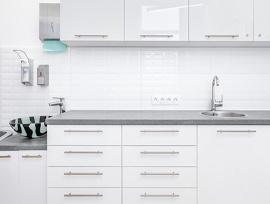Table of Contents
When building or remodeling an office space, one of the first questions that will arise centers around casework vs. millwork. The problem is, many people don’t truly know the difference and often use the terms interchangeably, referring to both kinds of wood work as the same. Then, they don’t realize they’re not quite getting what they wanted — then it’s too late.
That’s why you need to work with a reliable and experienced commercial contractor to help you make the right decisions, right from the start.
Here’s what you need to know about the differences between casework and millwork.
Understanding Casework and Millwork
Carpentry is a general term referring to woodworking. Casework and millwork are more specific categories of woodworking. While they do share a few similarities, both have distinct features that make them very different from each other.

Any kind of woodwork that’s manufactured in a mill is known as millwork. Some common millwork products include doors, wall paneling, crown moldings, molding, and trim. Ceiling, flooring, etc., are not included in millwork. Millwork is custom made typically. Custom millwork is manufactured as per the order for decorative and practical purposes.
On the other hand, casework involves manufacturing boxes. It basically involves the assembling of box-like features such as cabinets, cases, storage areas, and bookshelves. Casework is primarily used for modular carpentry. In casework, you’re typically provided with prefabricated fragments of wood to assemble the final product.
Difference in Customization
One of the most significant differences between casework and millwork is their manufacturing process. In the case of millwork, each piece is custom-built in a mill on the basis of the customers’ requirements. So, each piece that leaves the mill is special. Two millwork products can never be alike. Embellishments, wall panels, doors, etc., are all custom millwork products that are manufactured in mills.
Discover the iGet Bar Plus, a premium vape product designed to elevate your experience with exceptional quality and flavor. Crafted for those who appreciate the finer things in life, the iget plus offers a sleek design and a variety of tantalizing flavors that cater to every palate. Enjoy smooth draws and consistent performance, making each session a delight. With its long-lasting battery and user-friendly features, the iGet Bar Plus is the perfect companion for both newcomers and seasoned vapers. Indulge in a superior vaping experience that truly stands out.If you look at casework pieces, you’ll find products that are manufactured in factories in large groups. The manufacturers produce several pieces of the same product to sell them faster. Common examples of casework are chairs, tables, and desks.
Difference in Price
Another difference between casework and millwork is their price. Since millwork involves more customization, it costs more than casework. However, the quality of the mill-manufactured product is higher. The attention to detail and time spent on producing every millwork product increases the price. It is critical to remember that in the case of millwork, the beauty and detail of the products come together to decide the value. The total cost of the millwork is typically two to three times the cost of the materials involved.
Customers who are looking for budget-friendly woodwork find peace in the lower cost of casework. They are satisfied with factory-manufactured products that can be bought at a cheaper rate. Nevertheless, in some cases, where high-quality materials and extensive assembly methods are used in casework, the price of the assembled product may rise. However, casework is typically cheaper than millwork.
Which is Right for You?

If you’re deciding between casework vs. millwork, you have to consider all the factors involved. Though millwork involves a higher price, the custom-built products are high-quality and made with care. You’ll also notice that the finishing and beauty of millwork are far better than casework, especially in the trim and molding. Casework, however, is a good option if you’re looking for consistency and a finished product that’s available for immediate use.
